The sea has been ‘moderate’ – (slightly lumpy), during the night, but has settled to ‘slight’ – (that’s calm to you and me), at breakfast. The sun shone and Pendeen is in sight, soon to be followed by Cape Cornwall. Some days are perfect.
photography
The Exe – 5/6
So . . . Topsham to Teignmouth. It’s 1130 here. I’ve promised to be home by the middle of the afternoon; but I’m enthralled by what I am seeing . . .


The sea lies down there. Between here and there the channel goes over to the left bank and then back to the right bank before a stretch down the middle and then over to the right and back again to the narrow entrance. Straight on is not an option.

Lympstone on the left bank.


‘The price of neglect’ again. Someone loved her once. I wonder what happened.

In the water ski area a young women comes off her skis and skims across the water towards ‘Blue Mistress’. I ask if she’s ok, she smiles and says yes. but she is rubbing her nose. The ski boat picks her up quickly and they go back to the Exewake barge.
They are laying the tables for lunch on The River Exe Cafe.



The bird building his nest just forward of ‘Bloodhound’s’ wheelhouse makes me smile -(crow’s nest?)
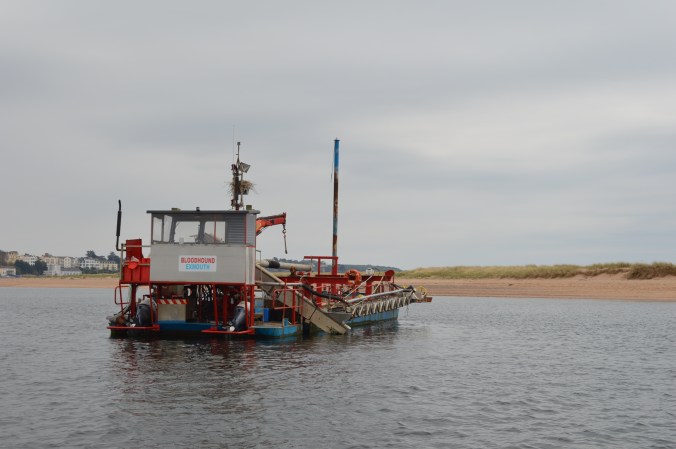
Round the tip of Dawlish Warren where we have walked so often.

A young family enjoying the beach dressed in fleeces.
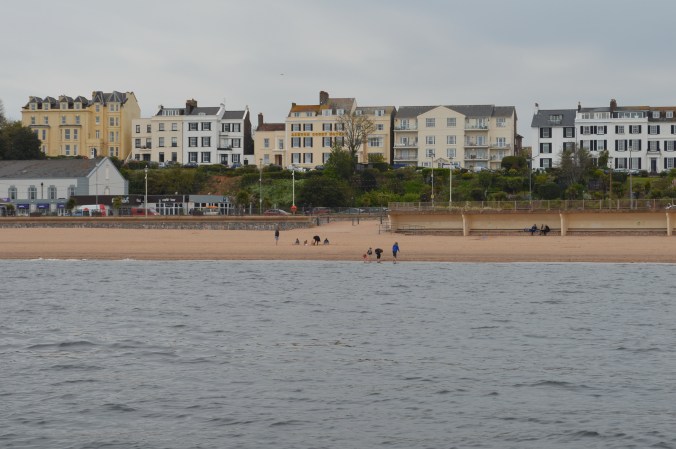
I reach the entrance buoy. It is colder now, the wind has got up. I climb into my heavy weather gear to keep warm, and set the sails for home.
(to be continued)
Images by Bill Whateley
The Exe – 4/6
The day begins calm and cloudy. I awake refreshed. There is no hurry, the tide will not suit until 1030 at least. There’s an egg for breakfast, peanut butter on a biscuit and coffee.
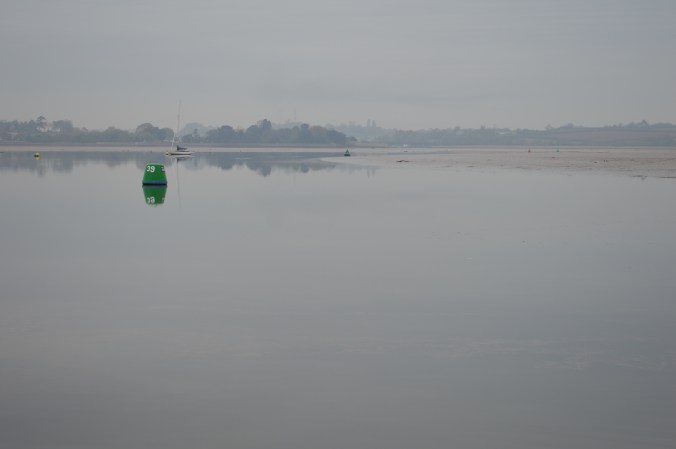
During the night, I reflected on yesterday’s comments about attitude. “The Captains” thought I should stay away from that stuff (“You’ve no more sense than you were born with”), but nothing we ever do occurs in a vacuum. My little research trip is no exception. There are always other things going on and they will flourish whether we like them or not. If we don’t speak up, what then?

I am determined to take the boat to Topsham before heading for home – I’ve promised to be back in Teignmouth in time to greet my in-laws. The channel gets narrower and shallower further up and I am torn between needing to get away early and avoiding going aground. I start the engine and drop the mooring at 1030.

Cloudy or not, the morning is stunning. The channel winds abruptly. The outer edge of the curve is the deeper part.

I have around 3 metres at the turn, which descends to 2 metres a little further on.

and so I reach Topsham . . . by water, thinking of ‘Ceres’ – (previous post).



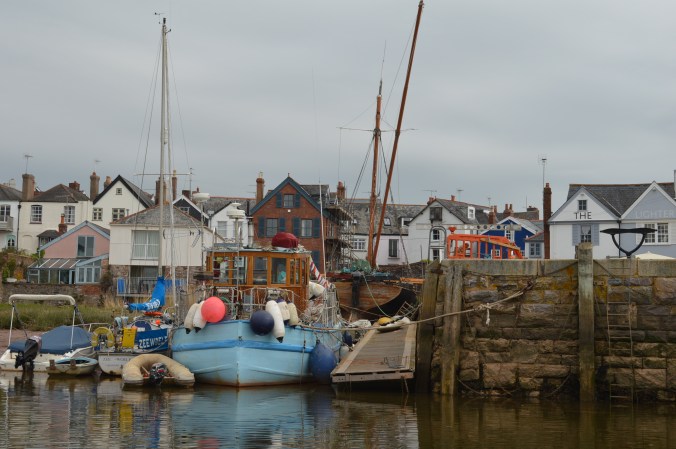
The original plan had been to moor here at Trout’s Boatyard for the night. That would have been a totally different experience – very fine, but I would have missed everything I saw this morning.

This is as high as we go. I make a tight turn to enjoy this sight . . .

I knew she was there from an earlier visit on foot; just a hint of what it must have been like in ‘Ceres” time . . .

(to be continued)
Images by Bill Whateley
The Exe- 3/6 (a longer-read)

‘Blue Mistress’ is on a mooring at Turf Lock on the Exe Estuary; the wind is getting up and the temperature outside has fallen. There are no other vessels on the moorings here today. I have decided to remain on board, despite the proximity of the Turf Hotel. There are ham and eggs, fruit and beer in the locker for later. For now I have found a biscuit, made a cup of tea and converted the cabin to ‘office’ mode. I am now ‘working’.
Forebears
Elsewhere on this site there are images of and references to the ‘Ceres’, a Westcountry trading ketch, built in 1811. My family acquired her in 1852 and owned her until she sank in 1936. She served a hard working life of 125 years.
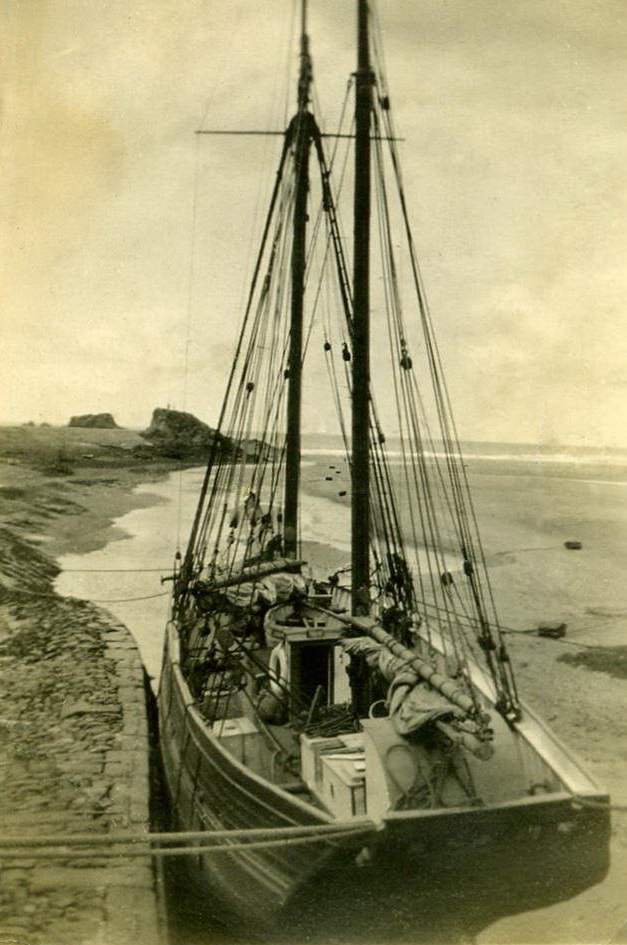
‘Ceres’ touched five generations of my family, three of whom owned her. The first of the owners was Captain Henry Petherick, my great great grandfather, then Captain William Petherick, my great grandfather and finally Captain Alfred Petherick, my grandfather. During that time, William’s brother, Captain Walter Petherick, was master of her for over fifty years, and their brother-in-law, Captain Barnabas Shazell, started as an apprentice aboard her, aged 14. The latter married Henry’s eldest daughter. For a while he held shares in ‘Ceres’ before going on to own another trading ketch, the ‘Joseph and Thomas’.
So, five captains from three generations, drawn together by one piece of technology – a wooden sailing ship, together with the knowledge, skills and judgement required to manage that vessel.
One of the features of relatives is that they will be our relations for ever. Whenever I go to sea in my small boat – all 25 feet of it, I ‘carry’ those five captains on board with me. There they are, standing on my cabin top in their great big sea boots, judging how I coil my lines, how I set my sails, how I steer my course. I enjoy sailing ‘alone’ and they are generally good natured about this, but, now and then, one or other will mutter, “The boy’s no more sense than he was born with.”
The Westcountry trading vessels were the bulk carriers of their age – before good roads, railways, lorries. Small ships like ‘Ceres’ – (she was just over 62 feet long), knew intimately the ports, small harbours and beaches of the coasts of Britain, Ireland and the English Channel. Typical cargoes were coal, manure, slate, salt, granite, cement, limestone, iron ore, barrels of resin, fire bricks, general cargo, scrap iron, potash, pine wood, china clay, pipe clay, blue clay, oats, barley or potatoes.
Purpose
My intention, apart from the healthy desire to learn about my forebears, is to gain as much of the knowledge, skills and attitudes of the seamen who sailed in those days as I can, including experiencing the pilotage necessary to enter and leave the ports and harbours they frequented.
For instance, on 27th September 1882, ‘Ceres’, Captain William Petherick, master, left Port Madoc for Exeter, carrying 85 tons of slate. I don’t yet know the date she arrived, but on 19th October, she left Exeter for Bideford, carrying 82 tons of manure; thence in ballast back to Port Madoc, where she picked up another 85 tons of slate for Exeter. She spent Christmas there, and left on 3rd January 1883 for Bideford with 82 tons on manure.
The following winter, on the 18th December 1884, this time Captain Walter Petherick, master, she left Bristol for Topsham carrying 82 tons of manure. She remained in Topsham through that Christmas and left on 17th January for Bideford, carrying, bizarrely, 80 tons of manure.
Gaining experience
This afternoon, I am moored at the locks to the entrance to Exeter Ship Canal, the direct route to Exeter. I am within sight of Topsham (below) and planning to visit there tomorrow.

My own vessel, ‘Blue Mistress’, is, of course, very different from ‘Ceres’. I have the advantage of size in terms of maneuverability and draft, the use of an engine, and no cargo of slate or manure!

But the tides are the same, the currents in the channel, the effects of the weather, the need for careful pilotage – (remembering the above passages were made in the depth of winter). I wonder if ‘Ceres’ was able to sail up with the tide, or whether she was towed by a steam tug – saving time but adding expense. Where did she anchor up? What would the crew have seen on the banks of the estuary? The railway line would have been there, (Brunel’s short-lived Atmospheric Railway had been built in 1847). Powderham Castle was there and some of the older buildings along the way.
The question I am asking now is by this experience, can I learn more of my ancestors attitudes to their life at sea?
Why attitudes?
The wooden sailing ship is a form of technology – (“Technology: the practical application of knowledge especially in a particular area” – Merriam-Webster). In the case of ‘Ceres’, this practical application of knowledge worked for 125 years, and, as I have mentioned, this vessel was known to five generations of my family. We have to look hard these days to find technology that lasts so long. Indeed, many forms of modern technology are outmoded even before we purchase them. Therefore, particularly within Western societies, less is handed down in terms of knowledge, skill and attitudes based on the older technologies. I notice, in particular, my grandson’s ability to use digital technology, and wonder, “Is what he has gained in his access to and mastery of new technology equally matched by access to longer-term human experience passed down through the generations?” And if this is a question involving my grandchildren, it surely equally applies to my yet-to-be-born great grandchildren, and, indeed, my great great grandchildren.
Which raises another question, what is the human experience that is worth passing on? At this very moment, there are three attitudes which would seem to be relevant – namely tolerance, patience and respect. This is why I am looking at the mariners in my family, and wondering about their approach to life. (In the case of seamen, respect means respect for the sea, respect for the vessel and respect for fellow crew members). I don’t believe sailors are innately any more tolerant, patient or respectful than anyone else, but they work in an environment where the absence of such attitudes are soon noticed – and they have to learn to deal with it. There is a loose-tight approach. Sometimes, we must be less tolerant, less patient, less respectful, but always there is a limit. However, there are people, especially some of our leaders, who no longer seem to understand that limit.
So that’s the serious side of why I have made this passage – in fact, why I make any passage. Yes, it’s fun, but it’s more than that.
The ‘work’ I am doing this afternoon is on the transcription of a journal written in 1845 of a voyage from London to Hobart, Tasmania. Some 23 years later, in 1867, young William Petherick made a similar voyage as an able seaman aboard a barque to Shanghai and on to Montreal, before returning to London. Two weeks after he returned, he sat exams in Plymouth for his master’s certificate. He wrote about his voyage. The journal I am copying at the moment describes such a voyage in daily detail.
The ham and eggs, fruit and beer were all good. The day finished with a stunning sunset.

(To be continued)
Colour images by Bill Whateley
The Exe – 2/6
The night was cold. At 0400, I put on a sweater. It was too heavy – at 0500 I woke in a sweat. Perhaps that’s why it’s called a sweater.
The day began with a light breeze down the estuary and a fine pale sky. The incoming tide would not be high enough until 1030 at least. I watched it slowly cover the sandbank opposite – a solitary seal enjoying the sun.

This is a day for a short passage under motor – the wind is against me and I will have to follow the channel carefully. The rising tide covers all hazards. The buoyage is good and easy to follow – red can buoys even-numbered, green conical buoys odd-numbered; I have read the pilot books and know what to expect. In the event, the up-to-date chart, depth sounder and binoculars prove essential.
Cockwood, on the west bank, soon appears. (Two good pubs here, The Anchor and The Ship)

The Exewake water skiers have a base in the middle of the estuary

and the River Exe Cafe is moored off Starcross.

Powderham Castle peers through the trees

and, all at once, the price of neglect strikes home.
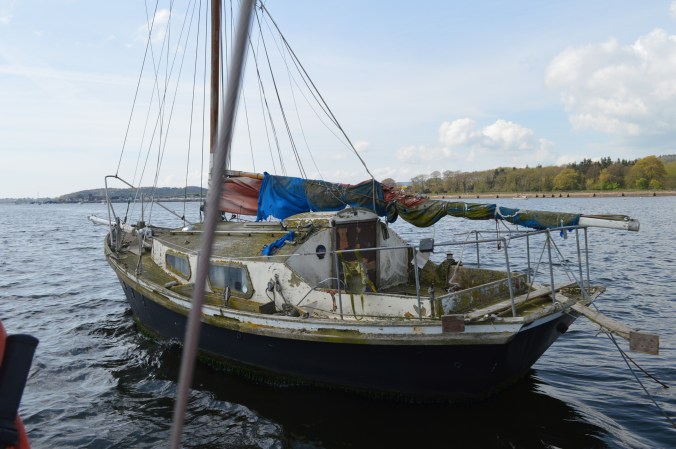
The channel winds close to Starcross Yacht Club, reputed to be one of the oldest sailing clubs in the British Isles, and then crosses the estuary towards the east bank,
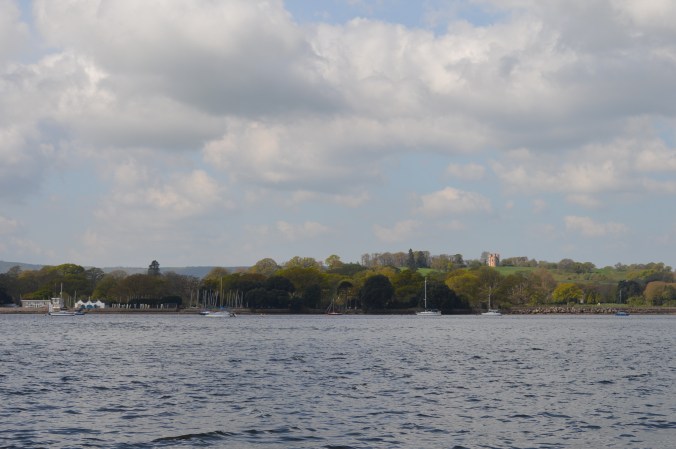
finally wending west again. The long bridge is part of a new cycle path. We have cycled it several times, having often, over the past thirty years, walked along the wall. Seeing it from the water is a first for me.

The passage takes about an hour. I watch the depth reading constantly, the shallowest point was about 3 metres; I need at least 1.5 metres, so no worries there. I pick up a mooring at Turf Lock; judging by the amount of mud on it, I suspect it has not been used since last year.
The lock is the entrance to Exeter Ship Canal, and the Turf Hotel a long-time favourite.

In the middle of the day, the wind changes and rises . . .

it becomes distinctly colder, and, as the tide drops, I settle down to work.
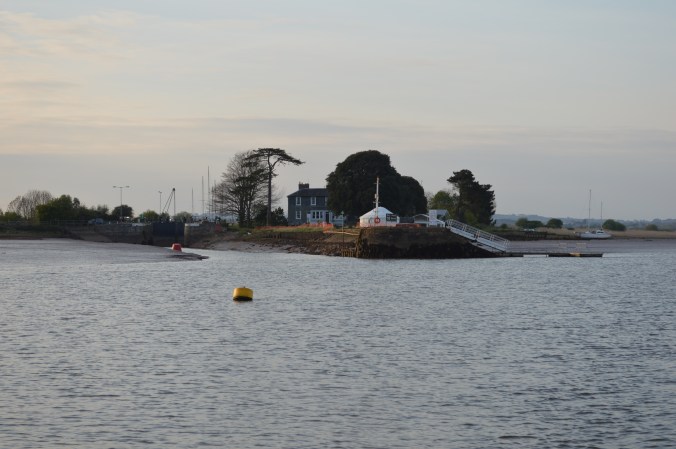
(to be continued)
Images by Bill Whateley
The Exe – 1/6
I found three spare days to spend on The Exe last week.
The navigation from the entrance to The Teign to the entrance to The Exe is only six miles; it is the pilotage on The Exe that makes it an “adventure”. The estuary is wide, the main channel is narrow and tortuous – and the mud sticky. The distance from the entrance to Topsham is just over seven miles. Perhaps twin keels and shallow draft vessels take it in their stride but Blue Mistress’ long keel doesn’t allow for careless mistakes.
This was my first visit. All ports and harbours have their local conditions – experience makes them perfectly manageable, inexperience requires extra care.
I spent the night on board and left Teignmouth at 0700. Dawlish stood out in the early morning sun.
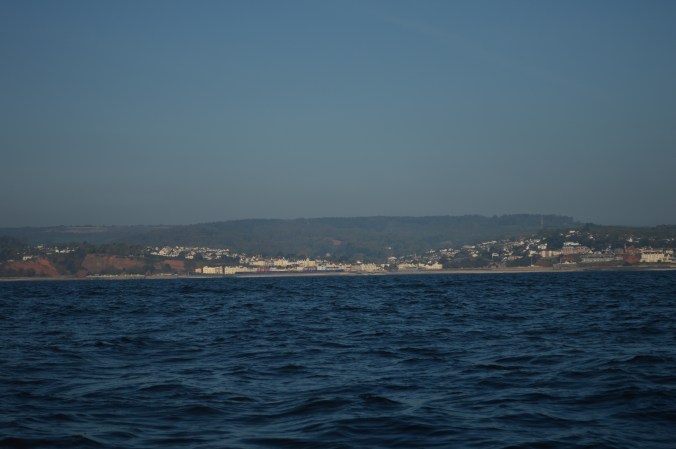
At The Exe entrance buoy, I took off the sails and motored. The tide was with me.

The channel here runs for a mile between Exmouth beach and the sandbanks off Dawlish Warren.
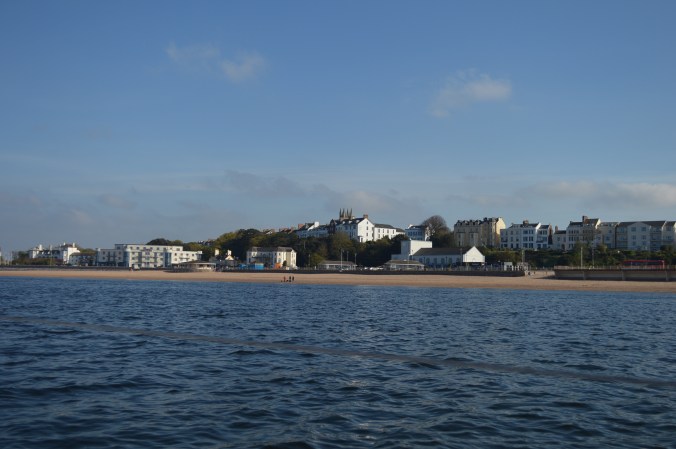
The edge of the channel is obvious at this stage of the tide.

Looking back towards Dawlish, there is an inshore passage; suitable for this trimaran perhaps, but I would hesitate to use it.

At the entrance to Exmouth Dock the channel turns sharp to port, creating gentle eddies today but exciting, swirling currents on a falling spring tide.

I picked up a comfortable visitors’ mooring in The Bight well before high water . . .

. . . and enjoyed a peaceful afternoon watching the traffic on the water and working on the boat.
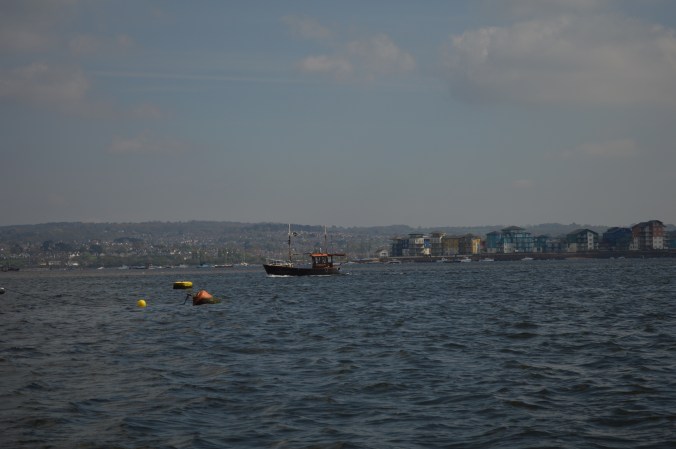
(to be continued)
Images by Bill Whateley
A boat in Teignmouth
I have been getting used to new surroundings – new for Blue Mistress that is. No longer the city of Plymouth, but the town of Teignmouth – two ports, different aspects.
We too have wharves . . .

and buildings along the water’s edge . . .
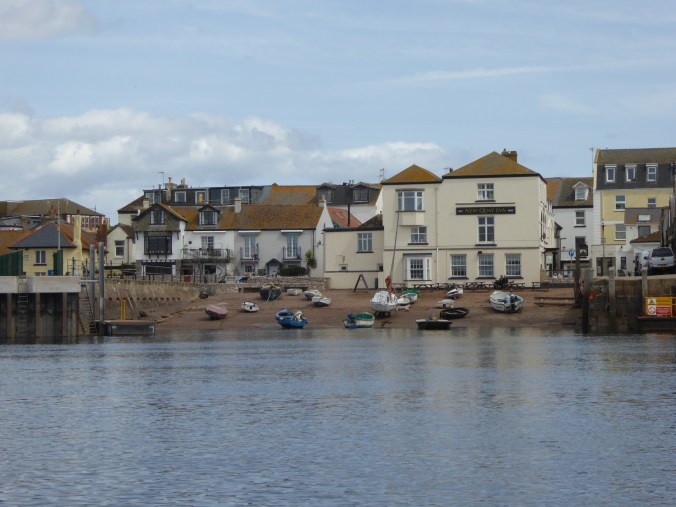
and good pubs.

The entrance is interesting with shifting sandbanks meaning work for the dredger . . .

The sailing is less crowded . . .

Teignmouth is not only a holiday resort but a working port . . .

Vessels negotiate an awkward entrance.

Once in, their presence “alters the shape” of the town.

They continue the long tradition with this as with every other port – looking outwards, trading with other ports, both home, as with Celtic Ambassador, and abroad . . .

I am going to enjoy sailing from here.
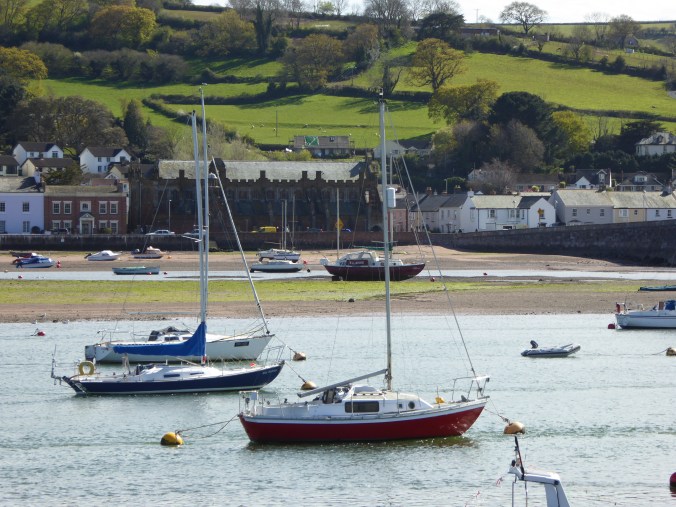
(Images by Bill Whateley)
One morning
One January morning in Teignmouth,

A water study
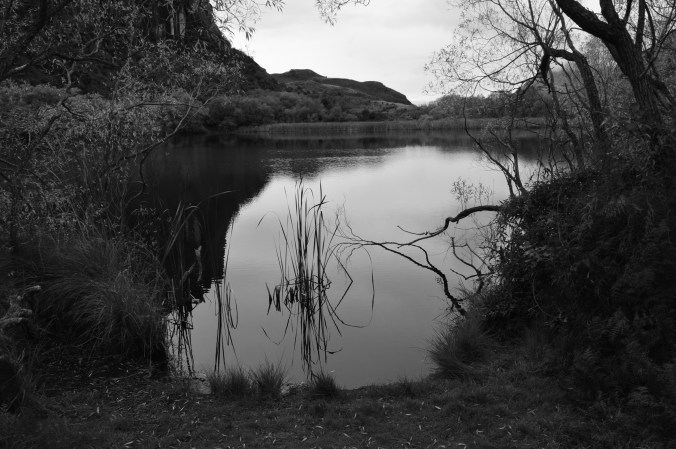

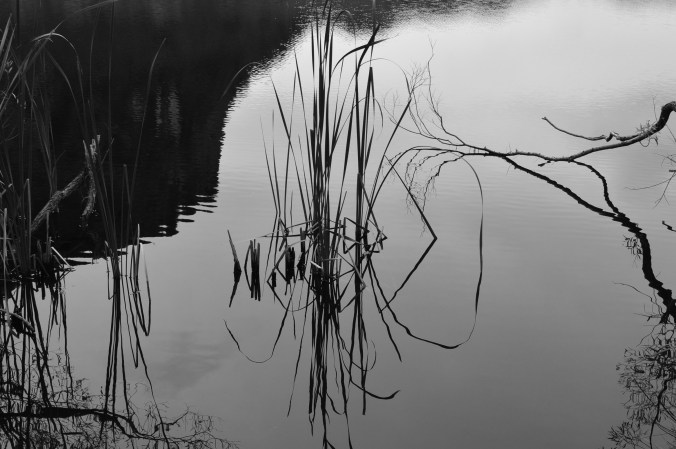
Near Lake Wanaka, New Zealand, April 2014
Marine photography
2 – My approach to photography
When I was a dentist, I took photographs all the time – mostly macro settings of small objects and areas. These were essential records of what I was seeing.
In my private life, my photographs have also been records – records of places, people and details. My family will tell you somewhat wearily, “He takes photographs of boats mostly!”